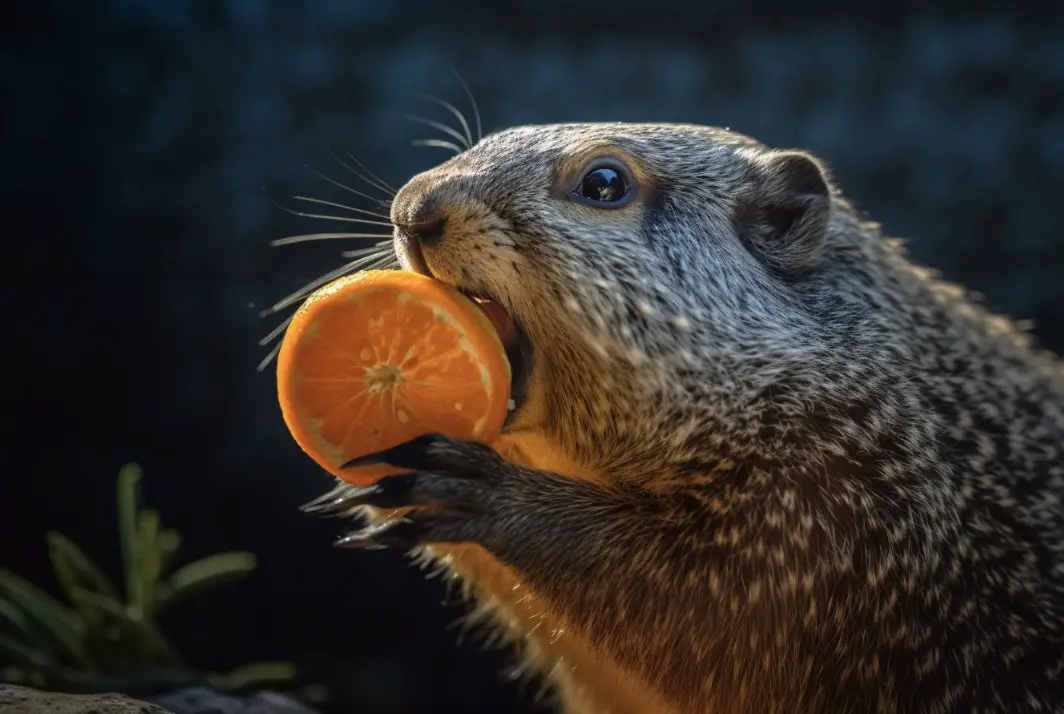As a backyard owner, I’ve often wondered about the eating habits of the various critters that roam around my property.
One animal I see quite frequently is the groundhog.
These adorable rodents are often seen munching on grass and other vegetation, but do they eat oranges?
The short answer is yes, groundhogs can eat oranges, but it’s a bit more complicated than that.
In this post, I’ll be diving into the world of groundhogs and their relationship with oranges.
Contents
Groundhogs: A Quick Introduction
Groundhogs, also known as woodchucks, are large rodents native to North America. They are primarily herbivores and feed on a wide variety of plants, including grass, clover, and other vegetation.
They are also known for their burrowing habits, creating intricate tunnels to live in and escape from predators.

When Do Groundhogs Eat Oranges?
While groundhogs can eat oranges, it’s not their primary source of food. They are more likely to eat oranges if they come across them accidentally, rather than seeking them out.
This means that if you have an orange tree in your backyard, a groundhog might eat some fallen fruit if it happens to stumble upon it.
How Do Groundhogs Eat Oranges?
Groundhogs have sharp teeth that allow them to easily bite into the tough skin of an orange.
They will typically eat the entire fruit, including the rind, pulp, and seeds.
However, they may leave some of the rind behind if it proves too tough for them to chew.
How Often Do Groundhogs Eat Oranges?
Since oranges are not a primary food source for groundhogs, they don’t eat them very often. It’s more likely for a groundhog to eat an orange only if it comes across one by chance.
Therefore, it’s difficult to determine an exact number or frequency of groundhogs eating oranges, as it largely depends on the individual groundhog and the availability of oranges in its habitat.
Why Do Groundhogs Eat Oranges?
Groundhogs eat oranges for the same reason they eat other types of vegetation – for sustenance. Oranges provide vitamins, minerals, and energy that groundhogs need to survive.
However, as mentioned earlier, oranges are not a primary food source for groundhogs, so they will only eat them if the opportunity arises.
Implications for Backyard Owners
As a backyard owner, it’s important to understand the eating habits of groundhogs in relation to oranges. If you have an orange tree on your property, there’s a chance that a groundhog may eat some of the fallen fruit.
This might not be a major concern, as groundhogs are not known for causing significant damage to orange trees. However, if you notice a groundhog consistently eating your oranges, it might be worth considering other methods to protect your fruit, such as fencing or netting.
Other Animals That Eat Oranges
Groundhogs are not the only animals that eat oranges. Many other animals are known to enjoy this tasty fruit, including:
- Squirrels
- Raccoons
- Deer
- Opossums
- Birds (such as orioles and mockingbirds)
It’s important to keep in mind that just because an animal can eat oranges, it doesn’t mean that oranges are a major part of its diet. Like groundhogs, most of these animals will eat oranges only if they come across them accidentally.
How To Keep Groundhogs Out Of Your Yard!
There are several things that can be done to prevent groundhogs from digging and eating stuff in your backyard. I will list some of the strategies below.
Also, see my recent post if you want a full list of my favorite methods to keep groundhogs and gophers away!
1. Using ultrasonic sound
Groundhogs, like other bigger mammals that may invade your garden, tend to have very good hearing. This means that loud or consistent noises will scare them away or at least shorten their visits.
Check out my full buying guide for these ingenious ultrasonic repeller devices here!
One of my favorite technologies to keep pests away from my backyard is these cool solar-powered ultrasonic sound emitters that you can buy right from Amazon! In my experience, they really work, and the solar panels on top save you the time and money of changing batteries all the time.
They will also work against other rodents like gophers, mice, and rats!
2. Sprinkling natural repellents
Groundhogs may be scared off by using natural scents such as coyote urine or predator scents.
They may also cause them to leave if there is a combination of sounds being played from a radio. The sounds include the sound of barking dogs and coyotes.
You can sprinkle dog hair, cayenne pepper or strong enteric oils and other natural repellents around the garden to keep the groundhogs away.
See my complete list of humane ways to keep groundhogs away from your yard for more tips and tricks!
3. Fencing around the garden
You can also fence around your garden to keep groundhogs from entering the garden. It should be at least 3 feet deep and have a double row of fencing.
Groundhogs are good diggers so it has to go underground or they may find a way into the garden even with the fences in place!
4. Using live traps
You can use a live trap to capture groundhogs and move them to another area. Live trapping is currently the most humane way of groundhog control. Once you have removed all groundhogs from an area, it is important to ensure that they do not come back by using fencing or other barriers to block access.
You can also just buy a live trap, as the sturdy metal ones shown here:
To lure the groundhogs in, you can use one of the numerous favorite foods of groundhogs or an optimized extra attractive formula like this one to make the catch even quicker!
5. Using natural pesticides
There are pesticides or rodent toxins that can be used to kill groundhogs on your property. These may also affect other animals in the area so it is important to ensure that they are only sprayed on the targeted plants.
I do not recommend these, as I prefer more humane ways as described here. Also, anything that kills an animal will also harm humans to some degree, so go for a repellant rather than a toxin if you go the chemical route!
6. Using Scarecrows
You can use a scarecrow in your garden to keep groundhogs away. Groundhogs are afraid of novelty so time-sensitive or motion-activated scarecrows may also be effective in keeping them out of the garden.
7. Using Lights
Groundhogs are not strictly nocturnal animals but they are most active at low light so they do avoid areas with bright lights.
Motion-activated lights, sounds, and sprinklers may help prevent groundhogs from entering your yard.
Any blinking light will confuse and scare away groundhogs from your yard, especially if they are motion activated and sudden!
8. Motion-activated sprinklers
Like most animals, groundhogs hate surprises, and they will run away if suddenly sprayed with water. I like this solution because it is humane, simple, effective, and does not require much time to set up.
The Havahart 5277 is a motion-activated sprinkler that is activated by the movement of animals up to 25 feet away and sprays them with a harmless water jet, frightening them off and keeping them at bay.
The included metal stake makes it easy to install in your garden, and the sprinkler can be rotated 180 degrees for maximum coverage.
## Conclusion
In conclusion, groundhogs can eat oranges, but it’s not a primary food source for them.
They are more likely to eat oranges if they come across them accidentally, and they will typically consume the entire fruit.
As a backyard owner, it’s important to understand the eating habits of groundhogs and other animals that might be attracted to your orange trees.
By being aware of these habits, you can better protect your fruit and enjoy a bountiful harvest.
















